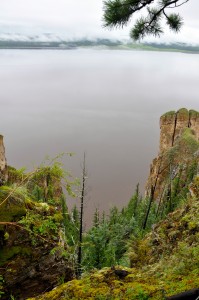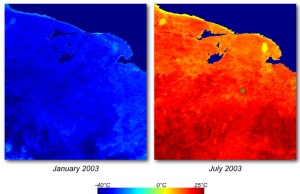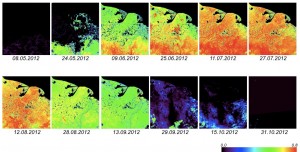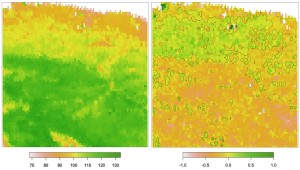14. August 2013 |
Michael Schaepman |
Comments Off on Closing down
by our staff writers
August 14, 2013
Thank you all, for contributing, reading and supporting our activities!
This is the last blog entry for the summer 2013 season.
Finally, everyone has returned safely and without major hassle, injuries or other happenings! We wish to thank all contributors to this successful expedition and hope you have enjoyed reading this blog. We will be back next year with more information. We also thank all of our readers for their interest!
Trailer
Let’s finally quickly review the main actors and contributors to this expedition in short.
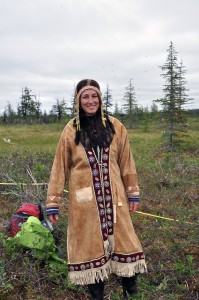
Expedition lead in all situations: Gabriela Schaepman-Strub (Photo: T. Maximov, July 2013).
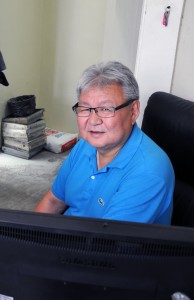
Trofim Maximov, the best science and host you can get in Yakutia (Photo: G. Schaepman-Strub, August, 2013).
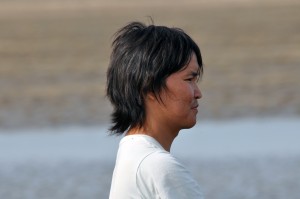
Stas Ksenofontov, the organizing expert for everything! (Photo: M. Schaepman, August 2013).
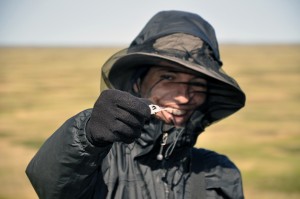
Maitane Iturrate, the ‘crazy Spanish’, who never stopped working (Photo: G. Schaepman-Strub, July 2013).
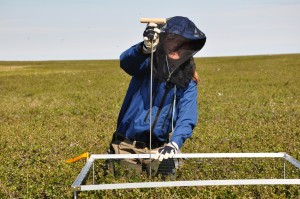
Inge Juszak, field work under any circumstances (Photo: G. Schaepman-Strub, July 2013).
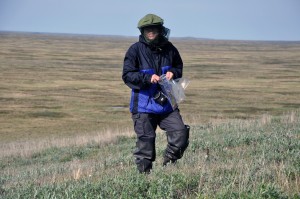
Olga Khitun, never resting to get all (!) species determined (Photo: G. Schaepman-Strub, July 2013).
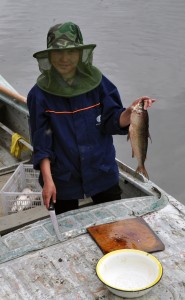
Lena, a cook no one wanted to miss any meal … (Photo: M. Schaepman, July 2013).
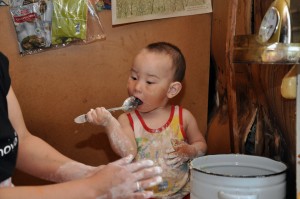
Lena’s son Ilya, a great help in- and outside the kitchen (Photo: L. Schaepman, July 2013).
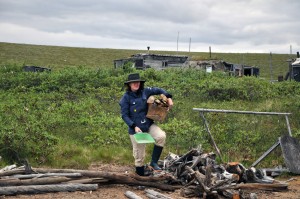
Angela Gallagher, whose life is more Tundra than anything else (Photo: L. Schaepman, July 2013).
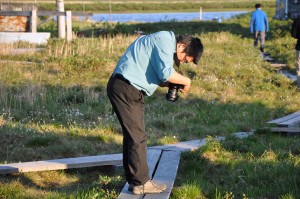
Bingxi Li – what did I photograph again?? (Photo: G. Schaepman-Strub, July 2013).
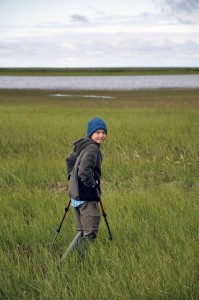
Linus Schaepman, returning ‘every year again’ (Photo: M. Schaepman, July 2013).
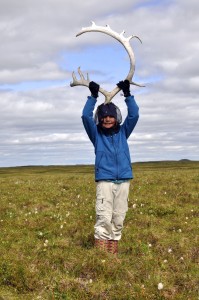
Anne Schaepman – ‘reindeers do not need to go back to school …’ (Photo: M. Schaepman, July 2013).
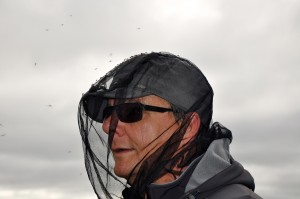
Michael Schaepman, responsible for the URPP GCB (Photo: G. Schaepman-Strub, August 2013).
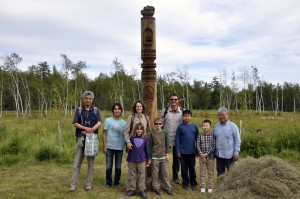
A farewell from Spasskaya Pad (from left: Rikie Suzuki, Stas, Gabriela and Anne, Linus, Michael, Nikita, Kyril, and Trofim (Photo: Roman, August 2013).
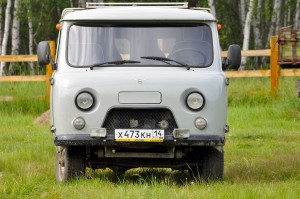
Guarantees the smoothest rides: Bukhanka and its driver Wasya (Photo: M. Schaepman, August 2013).
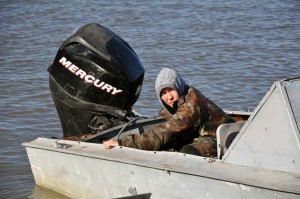
Guarantees the fastest transfers: Iwan and his outboard engine … (Photo: M. Schaepman, August 2013).
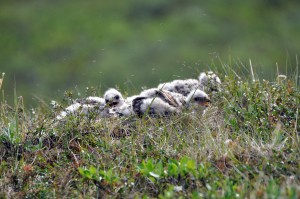
We will miss the fantasitc nature and wildlife (Photo: M. Schaepman, July 2013).
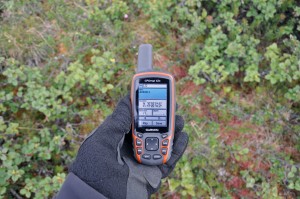
Let’s meet next year in the tundra again, maybe behind the Alnus 11 bush … (Photo: M. Schaepman, July, 2013).
Acknowlegements
We acknowledge support from the University of Zurich Research Priority Program on Global Change and Biodiversity (URPP GCB) for test site maintenance, project support and travel (G. Schaepman-Strub, M. Iturrate, M. Schaepman).
We acknowledge support from the Swiss National Science Foundation (SNF), project 140631 (Inge Juszak).
We rely on equipment and clothing from Transa.
Abgelegt unter: General
13. August 2013 |
Maitane Iturrate Garcia |
Comments Off on Returning home
by Maitane Iturrate
August 13, 2013
It is 10 o’clock and everything is packed and ready. In less than two hours, we will be at Yakutsk airport, heading back home. Today will be a long, long day (a day of 32 hours incuding the change of time zones).
We arrived at Yakutsk, again, yesterday morning, after having our last breakfast in Spasskaya Pad. It was really weird returning back to “civilization”, and to have a proper bed, a toilet at only one meter from the room and not at few hundred meters, supermarkets with a huge number of options in food… Indeed, we bought some food for lunch and it took us ages to decide what to buy. Once back to the accommodation, we needed to decide what to eat (so many options, including fruit, of course!!).
Our stay in Spasskaya Pad was great, like a kind of relaxing holiday. After the initial shock of not be able to do what we had planned, we decided to enjoy the experience of being in the Siberian taiga as much as possible. And the experience started really well, dinner and “bania”… our second “bania” in less than one week! The following day, Saturday, we had a guided tour of the installations, visiting and climbing all the measurement towers and enjoying the views. We were really lucky of having Aya as guide, we had lots of fun and lots of berries… we stopped every few meters and picked some berries. And after finishing the guided tour, he offered us birch sap juice, very tasty.
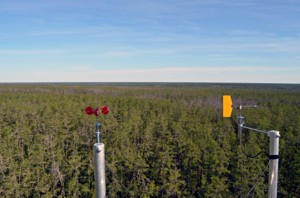
Spasskaya Pad flux tower (Photo: M. Iturrate, August 2013).
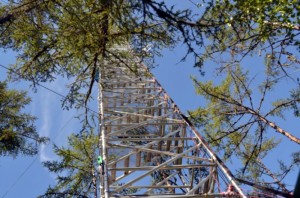
Spasskaya Pad flux tower (Photo: M. Iturrate, August 2013).
The afternoon was a working afternoon. My vegetation samples were dry, so time for weighing them. Inge helped me to write down the weight (thank you), so we managed to finish half of the samples before dinner. Although the other half was left, we decided to continue next morning as we were exhausted. It was a good decision because we were able to join the karaoke session. We sang and danced, first European songs and then Russian songs. It was wonderful. We feel really integrated, like two more Sakha people. After transforming the karaoke session into a disco session, I had time to listen to a couple of songs that one of the students, who attended the summer school, composed in Sacha, and to Stas playing the khomus, a traditional musical instrument used in the Sakha republic. I had even the opportunity of playing it, quite difficult.
Sunday morning was for finishing the weighing of my samples. The afternoon was for walking in the forest and picking berries. We only had a little problem, a summer storm. We were at almost two kilometers away from the research station when it started to rain cats and dogs. We returned completely wet, but with a big reward (just see the picture!!).
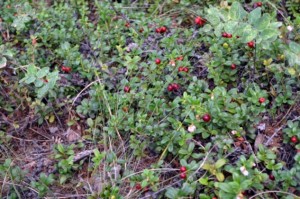
Vaccinium vitis-idea berry collection (Photo: M. Iturrate, August 2013).
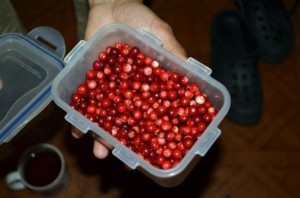
Vaccinium vitis-idea berry collection (Photo: M. Iturrate, August 2013).
During the evening-night, we were talking a lot to other people, learning new Russian words and exchanging cultural facts of the different countries (Japan, Germany, Russia, and Spain). I could even exchange some knitting patterns with the cook. She saw me knitting my cardigan and offered me going to her house in order to show me all the winter socks she was knitting. They were really beautiful and colorful. It was amazing how we managed to understand each other.
It was a bit sad to say goodbye to the people yesterday morning. But, who knows! Maybe next year, we can also spend some days in Spasskaya Pad before returning home.
Only half an hour to go to the airport. It will be a bit funny being again in Switzerland after such an experience. I am looking forward to starting processing all the data collected, but first a couple of weeks in Spain to rest and recover after so many weeks without stopping. It has been really nice to share this experience with all of you. Next year, more! Have a good summer.
Abgelegt unter: General
12. August 2013 |
Maitane Iturrate Garcia |
Comments Off on Last days in Kytalyk
by Maitane Iturrate
August 8, 2013
Tomorrow, we are leaving Kytalyk. It seems that it was yesterday when we arrived by boat, but five weeks have gone. The last week has been specially stressing. As Angela Gallagher told us: “the last week, you will be running as chicks”. And that is exactly what I have been doing all week: running and running, trying to finish everything. Thanks to this and to Bingxi Li, my nickname among the people in Kytalyk and IBPC is “the crazy Spanish”. I haven’t been able to do everything I wanted, and I have lots of data for the winter. After finishing the measurements of plant traits at plot scale, I started with plant traits at individual scale. Now, I have an important “library” of leaf optical properties and plant architecture for all the species in my plots.
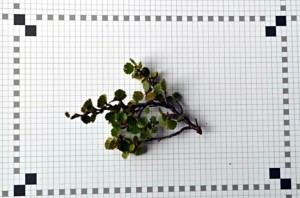
Betula nana branch from one of the ridge plots (Photo: M. Iturrate, August 2013).
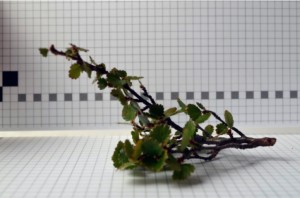
Betula nana branch from one of the ridge plots (Photo: M. Iturrate, August 2013).
As today is the last day, I have to do something that I promised to the master student from the Netherlands, Judith. It is twenty minutes before dinner time. The air temperature is 13.7°C, and we are ready for it: swimming in the river Berelech (water temperature: 12.1°C). Before having time for changing my mind and while Judith and Inge are taking off the winter clothes, I jump into the water. First, the feeling of not having enough air to breath, then the feeling of thousands of needles in your skin, after that a throat as if you were eating ice, and then, just time to enjoy. It is really great. But it is dinner time, so after only five minutes, we have to go.
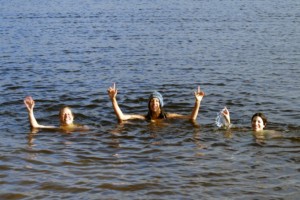
From left to right: Inge, Judith and “the crazy Spanish” swimming in the river Berelech (Photo: J. Limpens, August 2013).
The Kytalyk farewell dinner is great, even better than lunch (reindeer soup): Buckwheat with chicken, fish eggs with garlic and Lena’s famous fish pie. It will be weird not having any more this kind of meals or not sharing them with the same people anymore.
August 9, 2013
Leaving Kytalyk
It is one o’clock in the afternoon and we are still waiting for leaving Kytalyk. Our flight is at 16.20 hrs, we have two hours by boat to Chokurdakh, and the boat driver and Artiom are still trying to repair the fuel generator. We haven’t had electricity for the last two days. Finally, they decide to take the generator to Chokurdakh, so at 13.30h we are finally on the boat. We have contradictory feelings: we are really happy because in a few days we will be at home (and, in my case, enjoying the Spanish summer for two weeks), but, at the same time, we are a bit sad. It has been a great experience. I learned lots of new things and I have many new experiences. Everything here is magnified, especially feelings are really intense. Lots of work and little free time, but I don’t complain about that, it was really nice work for the first time with these tiny plant species. The only “problem” is the small progress of my cardigan.
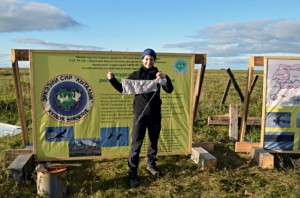
Cardigan knitting progress in Kytalyk (Photo: I. Juszak, August 2013).
At last, in Chokurdakh. The trip by boat has been a bit shaking and uncomfortable, but we are again back to civilization. We have not enough time to enjoy it because we are a bit late for our flight, so just time for throwing our luggage in the back of the van and directly to the airport. The flight is not delayed, so after carrying our luggage to the plane and helping to load it into the plane, we take-off at 16.20h. This time, we get two window seats and nobody next to us. Unluckily, the weather is too cloudy to enjoy the views during the whole flight, only the last hour and a half is quite O.K.
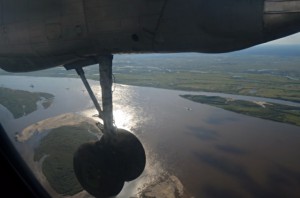
Ready to land in Yakutsk (Photo: M. Iturrate, August 2013).
We land in Yakutsk after three hours of flight. Again, we have to help to unload our luggage from the plane. When we arrive at the terminal, a smiley familiar face is waiting for us. Wasja is waving his hands, as friendly as always. We made lots of plans for our stay in Yakutsk, including two showers every day, at least. But instead of going to the accommodation, Wasja brings us to Spasskaya Pad research station in order to dry my vegetation samples before leaving the country, so second shaking trip of the day, but this time by car!
Abgelegt unter: Up and running
9. August 2013 |
Michael Schaepman |
Comments Off on Panoramic photographs of the Tundra and Taiga
by Michael Schaepman
Yakutsk, August 8, 2013
Communicating an overall impression of the Tundra and Taiga is tricky. In particular when we are used to see a mountain upfront every few kilometers, such as usually in Switzerland :-). The open and wide skies are really impressive out here!
We therefore share a few examples of panoramic images, giving a little impression of the wide and open space in Siberia! However, there is nothing like being you yourself out there to experience this unique scenery!
Around Kytalyk

Panoramic view of the Kytalyk research station (image center facing north) (Photo: M. Schaepman, July 2013) (full resolution).

Panoramic view of the Kytalyk area from across the Berelech river on a nearby pingo (Photo: M. Schaepman, July 2013) (full resolution).
Around Oyotung

Indigirka river near Oyotung (Photo: M. Schaepman, July 2013) (full resolution).

Tussock tundra near Oyotung. The small ditch to the right is a fragment of an unused supply road for abandoned infrastructure on the nearby hills and can be seen on Google maps (Photo: M. Schaepman, July 2013) (full resolution).
Around Yakutsk
Buluus Icing
Icings (also called ‘Aufeis’ or ‘Naled’) usually occur when groundwater is discharged into a river. The (relative to outside temperatures) warm groundwater discharges also during freeze conditions and supplies the icing with water all year round. It freezes rapidly in winter, resulting in a layered structure of the icing. Icings vary substantially temporally and spatially. We visited Buluus icing south of Yakutsk – fascinating to see (in particular when temperatures rise to more than 30 deg C (which was obviously not the case when we were there …)).
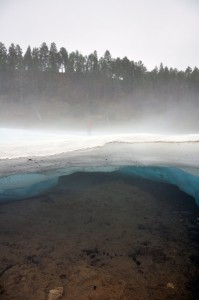
Buluus icing near Yakutsk (Photo: M. Schaepman, August 2013).

Panoramic view of Buluus icing (Photo: M. Schaepman, August 2013) (full resolution).
Lena river
The Lena river originates in the Baikal mountains and enters the Siberian lowlands near Yaktusk. Due to high precipitation in July and August, the water level was unusually high in 2013 and much sediments were carried by the river. Maybe therefore fishing was not such a success as planned …
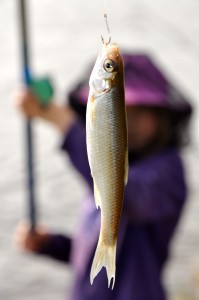
Fishing success in the Lena river (Photo: M. Schaepman, August 2013).

Sandbank in the middle of the Lena river approximately 50 km north of Yakutsk (1660 km to mouth, 2740 km to source) (Photo: M. Schaepman, August 2013) (full resolution).

Elanka, a small settlement across the famous Lena pillars (Photo: M. Schaepman, August 2013) (full resolution).
Meet Bolot Bochkarev
Bolot is the man behind the fantastic blog ‘AskYakutia.com’. Bolot acts as journalist, fixer and guide. We were lucky to travel with him for two days in Yakutia. He not only managed to organize earlier this year a helicopter tour around Yakutsk, but also travels with raindeer herders in wintertime and helps movie teams to access the far Siberian north. Should you need any expedition support or information on Yakutia, AskYakutia or contact Bolot – an invaluable source of information for all adventurers – we much enjoyed staying with him!
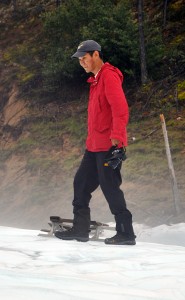
Bolot Bochkarev, the driving force behind AskYakutia.com on the Buluus icing (Photo: M. Schaepman, August 2013).
Abgelegt unter: General
7. August 2013 |
Veruska Muccione |
Comments Off on Vegetation dynamics in the Kytalyk region
by our staff writers
August 7, 2013
The region around Kytalyk is characterized by some of the World’s strongest spatial gradients. Most conspicuous is the temperature gradient. The northern part of the region borders the Siberian Sea and is more temperate than the inland, although it is still extreme compared to our sense of temperate. The figure below is a satellite-based land-surface temperature map that illustrates how, in winter (left), temperatures drop to minus 40 degrees in the south to ‘only’ about minus 20 degrees at the coast: a gradient over a distance of less than 300 km. In summer (right), this gradient is inverted, thus amplifying differences between the regions. The field team is in the bright red region (green dot in the summer map) and therefore temperature seems no concern at the moment. Reality, however, is not always as it should be (see blog post “the weather in Kytalyk this summer“).
Vegetation systems strongly react to various climatological constraints: in winter, it is dark (radiation-constraint), cold (temperature-constraint) and frozen/snow-covered (water-constraint plus nutrient-constraint) and therefore uninhabitable for plants that need these elements for growth. Plant growth during the summer, on the other hand, is intense. The figure below illustrates this. It shows NDVI values, which form a spectral proxy for vegetation activity and range between 0 (no vegetation) and 1 (full cover of lush vegetation). The time range in this figure is May until October, which underlines how short the growing season is.
Despite this time-constraint (another one) of a short growing season, the arctic tundra plays an important role in the world’s carbon budget. Per unit area, it sequesters about a third of the yearly amount of carbon compared to forests, but in a very short time. The changes in the carbon budget with changes in climate may therefore be substantial and it is important to closely monitor variations in the growing season. Land-surface phenology is the study of these intra-annual dynamics and nowadays, we have more than 30 years of global NDVI data available for this purpose. Irene Garonna, a PhD student in remote sensing and affiliated to the Global Change and Biodiversity URPP, focuses on this type of vegetation dynamics. A quick look into her analyses tells us how the growing season varies spatially and how it changes over time. The figures below look different from the previous ones, because they are based on other satellite sensors with a coarser resolution (8×8 km, as opposed to 0.5×0.5 km) and they have a different projection (degrees instead of UTM). Nevertheless, the region is the same and from the map on the left, we can clearly distinguish the same coast-to-inland gradient as we saw before, but this time in length of growing season (number of days per year, 30-year average). The shorter growing seasons are in the north, where snowmelt starts later in the year (see the radar blog of July 25th). The map at the right, however, depicts the change in length of growing season over the past 30 years and indicates a lengthening of about 1 day/year in these northern areas. This might be linked to warming conditions in the arctic and a possible retreat of the sea ice. These and other effects along latitudinal gradients are research topics of the URPP.
Abgelegt unter: General
6. August 2013 |
Inge Juszak |
Comments Off on The weather in Kytalyk this summer
by Inge Juszak
Kytalyk, August 5, 2013
Today it’s finally my turn to write a blog entry. I changed the topic from “The 14 most urgent things to do before we leave” to “The weather in Kytalyk this summer”. “Up and running” would also be a good title. But let’s stick to the weather. It’s quite a nice topic as I can make a blog entry with lots of pictures. Let’s start with the temperature. It has been really cold for most of the time, maximum between 10 and 15°C, so I usually take my down jacket to go for breakfast, lunch or dinner in the dining room. Lena cooks in her part of the building so that the dining room has the same temperature as outside, just with less wind. The temperature sensors of my little stations recorded a maximum of 26°C on 11th of July. That day was really nice and warm, but two days later the maximum daily temperature was just 7°C. So it changes rather quickly, but bad weather seems to be more stable than good weather. Cool temperatures have the advantage of less mosquitos and it is even better if there is also some wind. I can say that each weather has an advantage. Only rain is not very good for most measurements, but we had an extremely dry summer this year. It hardly rained and usually just 0mm (as the weather forecast says).
During the first half of our stay in Kytalyk we had a lot of wind, but much less in the last couple of weeks. With no wind at all the river looks like a mirror. We had a wonderful evening and I took the picture below of the boat coming back from a little trip. It’s Lena and some guests from Chokurdakh who were here for few days.
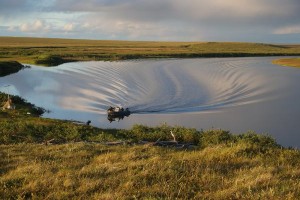
A boat arriving at the field station on a calm evening. Photo I. Juszak, August 2013
Most amazing about the weather in Kytalyk are the clouds. They change very quickly and ten minutes can make a big difference. The funny thing about the clouds here is that they seem to be very close. It looks as if you just need to stand on the nearest pingo to touch them.
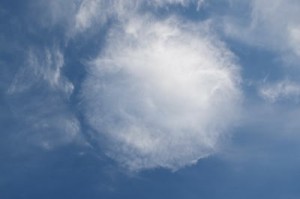
We get a lot of different clouds here. Photo I. Juszak, August 2013.
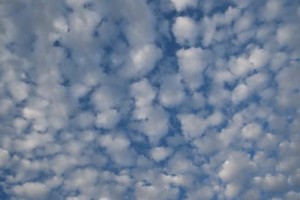
We get a lot of different clouds here. Photo I. Juszak, August 2013.
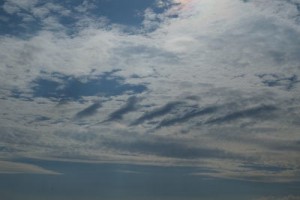
We get a lot of different clouds here. Photo I. Juszak, August 2013.
Most beautiful are the clouds in the midnight sun. Even now, the sun is still above the horizon at midnight. I take a picture every day before going to bed and usually the view is great.
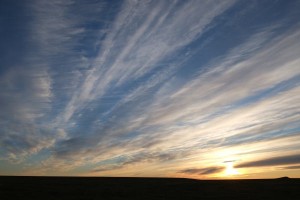
Midnight sun last Friday. Photo I. Juszak, August 2013.
The summer here is already coming to an end, the nights get colder and we got the first frost. The first shrubs have turned into nice colours, the birches have started getting red and the willows yellow. It will still take some time, but we can already see some changes. I really hoped for the cloudberries to be ripe before we leave, but I think they will not make it in the next 3 days. Well, maybe next year!
Abgelegt unter: General
2. August 2013 |
Gabriela Schaepman-Strub |
Comments Off on Exploring new opportunities around Chokurdakh and Yakutsk
by Gabriela Schaepman-Strub
August 1, 2013
The regular reader of this blog might have noticed that the original group has split up into two parties: Maitane Iturrate and Inge Juszak will be staying for another 2 weeks in the field site at Kytalyk to continue the measurements, while the rest of the party has left the core site. We first travelled to the north of Chokurdakh to explore the Оyotung (Оиотунг) hill-site area as potential new measurement site. A well-drained area, with highest hills reaching more than 300m a.s.l. The Soviet Union army constructed a gravel road to the top hills, leaving two heavy machines behind. The top of the hills are covered by lichen tundra, with increasing plant diversity towards the river lowlands. The zone along the Indigirka shows the highest plant diversity. Beautiful flowers, including thyme and arnica, reminding us the Swiss alpine flora. Oyutung was a special experience. We originally planned to visit this site for a few hours only, on the way to Russkoe Ustje. As the trip to the north was not possible as planned, a group of biologists and zoologists offered us to stay with them for a few days. Their cook provided us with fish for breakfast, lunch and dinner and with tea, all cooked on the open fire.
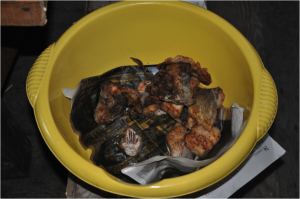
3 times fish a day – bucket with fried Chir (Photo: M. Schaepman, July 2013).
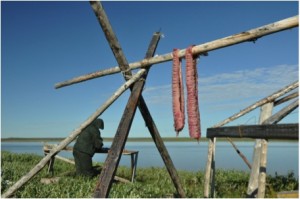
Cook preparing Jukala. Photo: M. Schaepman, July 2013.
At Oyotung there was a small fishermen’s hut where we could sleep, three persons on old, narrow sofas, two on the floor. During the last night, two local young men entered the hut, bringing some Jukula (air-dried fish) as a present for Maxim (whoever this is…). They had heard that somebody was using their hut and wanted to check – at 5 am…. They were obviously quite drunk and just wanted to find a place to rest, but we had to argue very carefully not to make them upset. When Michael got up and talked to Olga in English they finally understood that we were foreigners and immediately said – no problem. Olga, knowing how to deal with such situations, sent them to the big house where the local cook told them to leave. We finally heard their boat going off and felt asleep again. The next morning we drove to Chokurdakh on a very still Indigirka and flew out to Yakutsk. Lucky again with the flight, wonderful weather and beautiful views!
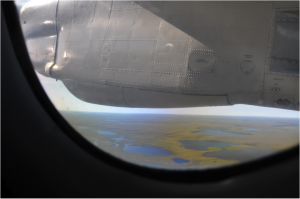
Last views over the Chokurdakh area on our flight back to Yakutsk. What a landscape, accessible only on the rivers or through the air as most of it is covered by lakes, rivers, and wetlands. Photo: G. Schaepman-Strub, July 2013.
After a dinner back in civilization (the best salad I ever had in my life 😉 Olga left us for St. Petersburg. On Sunday we were invited by Trofim Maximov to visit Spasskaya Pad, a research station of the Sakha Fluxnet. The site hosts two carbon and energy flux measurement towers of 32 m, reaching above the forest canopy, one in larch forest, the other one in a pine dominated forest. What an experience to climb up and see the forest from the top! These towers provide some of the very scarce observational data of the extensive continuous permafrost area in NE Siberia, with continental climate, to the scientific community. Thank you Trofim, Vasya, Stas, Roman, cook, and all others for safely driving us to the station, hosting us, guiding us through the site, for the bania, the tasty shashlik and mushrooms, and the soccer party!
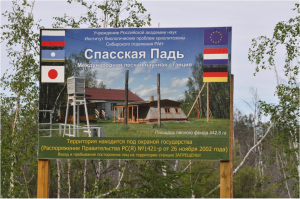
Entrance sign of Spasskaya Pad research station. Photo: M. Schaepman, July 2013.
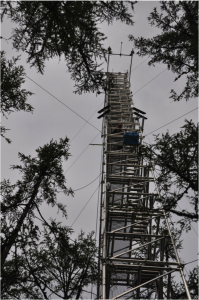
Climbing the instrumented flux measurement tower at the larch dominated site in Spasskaya Pad. Linus felt that it was quite windy at 32m…. Photo: G. Schaepman-Strub, July 2013.
While being in and around Yakutsk, we are preparing the documents for exporting our soil samples and discuss with our collaboration partners about future work and infrastructure needed on the Kytalyk site. October is approaching fast, that’s when we will need to submit a detailed research plan (exact location, frequency of data logging, etc.) for summer 2014 to the Russian authorities for their approval. If any big infrastructure or wood for boardwalks needs to be sent north, this should be done in winter time by truck on the frozen rivers, so better to start planning soon! But now it is first time for a few days of vacation to explore the area around Yakutsk! Maitane and Inge will keep you updated in the meantime about the last days of the field campaign in Kytalyk.
PS: Check SRF 4 – heute morgen. I was interviewed over the phone lately and the journalist promised that they will report about our activities on Friday morning.
PPS: The excursion to the Lena pillars was terrific! An interesting boat drive with visits to rock paintings and exploration of the flora. Finally arriving at the pillars – a foggy day, a mystic atmosphere! We were climbing the pillars and had a beautiful view over the immensely wide Lena.
How fortunate we were, visiting this Unesco world heritage site (since 2012) and not meeting any other person! http://whc.unesco.org/en/list/1299/
We can definitely advise to all researchers travelling through Yakutsk to take a few days off and get to know this tourist-free region! Beautiful landscapes and flora, very special! If you need help for your trips you might want to check this website http://askyakutia.com/ or get in contact with Bolot Bochkarev who helped us getting around.
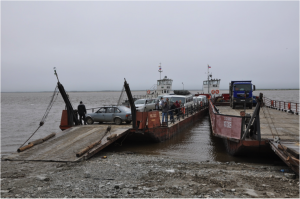
Ferry boats crossing the Lena river remain an adventure for us. Photo: G. Schaepman-Strub, July 2013.
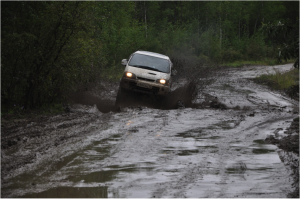
On the way to the Lena pillars with our experienced off-road driver Nikolai (Kola). Photo: G. Schaepman-Strub, July 2013.
What seems to be an off-road track is indeed a regular road between two villages. Yakutsk is the capital of a Republic of almost the size of India, yet there are not highways, and dirt roads start immediately outside of the city. Even within a distance of 100km of the city it is advised to use a 4 wheel-drive vehicle. Road conditions are severely impacted by permafrost dynamics and flooding. Winter time allows travelling on the well-maintained ice-roads on the Lena, an experience we save for next time….
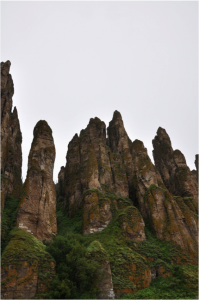
The Lena pillars are located within several kilometers along the Lena river, and are partially covered with vegetation which makes them very special. We walked up to the top at one point (about 2 km path, quite steep ;-), felt like walking through a rain forest as the air was very humid, lots of mosses and lichens on the floor and trees. Photo: M. Schaepman, July 2013.
Abgelegt unter: Up and running
2. August 2013 |
Veruska Muccione |
Comments Off on Winding down
by Angela Gallagher
Kytalyk, July 31, 2013
This is my finally summer in Kytalyk and I will be leaving in a few days to return to Amsterdam. I have been lucky enough to have travelled to Kytayk five times, both during the summer and during the Siberian spring where temperatures can be as low as -20oC. So I have very mixed feelings about leaving Kytalyk for the last time, with very little chance of ever returning to such a remote part of the world again. A large part of me will be very happy to be back in the land of running water, hot showers, and if reports from Europe are correct, I will not need my thermal underwear on a nearly daily basis. But I will miss Kytalyk, well elements of Kytalyk, and the whole field work experience. I don’t think anyone ever left here missing the mosquitoes or the toilets.
Although field work can have its daily grind of difficulties and dismay leaving you wondering if you are cut out for science at all, it does have some unexpected benefits such as a cure for repetitive strain injury and weight loss despite hovering up every bit of food put in front of you. Nonetheless, one of the best things about Kytalyk is the tiny temporary community of people that spend the summer here. Currently the Kytalyk population is 11, including Lena our wonderful cook and her two year old son and Dasha. We all work quite independently, coming together during meal times. Breakfast is quiet and sleepy, but at lunch and dinner everyone is a lot more animated. We sit around chatting and discussing the strangest topics happily unable to determine who may be correct due the lack of internet access. The conversation flows freer and becomes more whacky as the supervisors depart, but regardless the conversation around the kitchen table is a fantastic way to defuse any fieldwork induced frustrations that may have built up during the course of the day.
So for me I will miss the kitchen the most, the discussions and all the laughing. Kytalyk is without a doubt a beautiful place and I feel very lucky to be here, most of the time, but I don’t think it would be the same without the little community thrown together in the middle of nowhere.
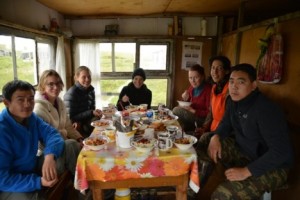
Dinner time for our little community in Kytalyk (Photo: A. Gallagher , 31 July 2013)
Abgelegt unter: General
29. July 2013 |
Michael Schaepman |
Comments Off on With a little help for my friends
by Michael Schaepman
July 27, 2013
Travelling far raises expectations and wishes! Also this time, we were well prepared with questions and wishes before leaving and we try now to answer some of them, prior to returning for more details …
Samuel from the soil group provided the team with tubes to be lowered into the soil at the Kytalyk site – this is well underway! Additionally, in search for a perfect plant nursery for this highly labelled isotope plants, we came across a well suited greenhouse infrastructure and recommend to establish it as a remote MICE station for Samuel.

Unused greenhouse infrastructure at the Ayutun site (Photo: M. Schaepman, July 2013).
Kentaro and Rie from evolutionary biology asked us to spot some plant species they are interested in as well. Due to heavy workload, a junior plant spotter team was put in place and it successfully discovered almost all species on their wish list, but was finally more interested in the more uncommon species such as the one shown below.
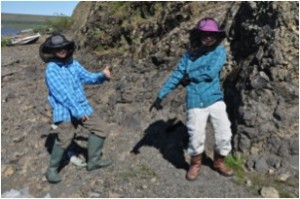
Junior plant spotters at work at the Ayutun site, approximately 40km north of Chokurdakh on the Indigirka river banks (Photo: M. Schaepman, July 2013).
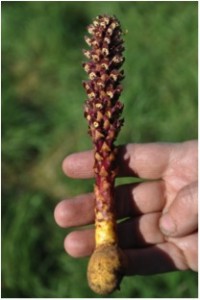
Non-photosynthesizing parasitic plant living on Alnus (Photo: M. Schaepman, July 2013).
Wolf, also from evolutionary biology, asked us to look out for flies. Not regular ones, but dungflies. First, we needed to find large grazing herbivores in the tundra (producing dung J). Hearing about herds of 500’000 reindeer one might think of an easy task – but it was not. Luckily, we found a few grazing animals, but the dung was completely free of any flies (it might have been too cold (at around a few centigrade above zero) at the time). With the help of colleagues from Yakutsk, we learned that those dungflies are not abundant in this region and we are looking forward to a more southern location to spotting them! The junior plant spotting team decided spontaneously to convert to a junior animal dissection team …
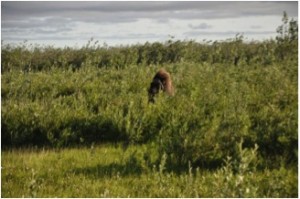
Muskox (Ovibos moschatus) grazing in the tundra close to Kytalyk (Photo: M. Schaepman, July 2013).
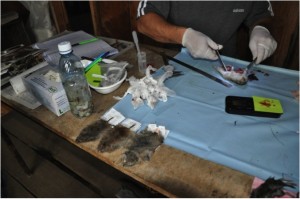
Zoologists from Yakutsk at the Ayutun site, inventorying for the first time small rodents (mice, spitzmaus (sic!) and lemming) populations in the Yakutian tundra (Photo: L. Schaepman, July 2013).
Erich, a remote sensing specialist with a flair for aircraft, is provided with almost unique aircraft spotting images such as the ones below.
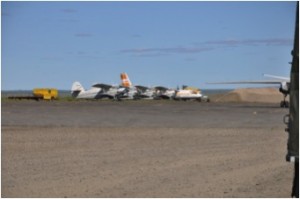
Chokurdakh airfield populated with Antanov (AN-2, AN-4?, AN-24) aircraft as well as a MI-8 helicopter. The wingtip to the right is our (cargo-)aircraft (Antanov AN-26-100) with luggage self-loading (Photo: M. Schaepman, July 2013).
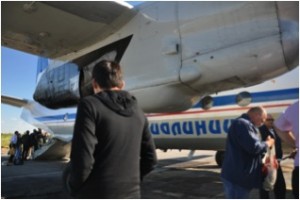
Self-unloading cargo and luggage from the Antonov AN-26-100 at Yakutsk airport. Luggage is strictly limited to 20kg per person and every spare gram is filled with frozen fish (Chir), being the heaviest part of the luggage (Photo: L. Schaepman, July 2013).
Finally Reik – a remote sensing Phd – volunteered to join this campaign. Unfortunately, because of many other obligations, he finally was unable to join in. We therefore provide him with a few impressions from the trip from Kytalyk to Ayutun (indeed, we had to skip Russkoye Ustye because of bad weather and unavailable infrastructure).
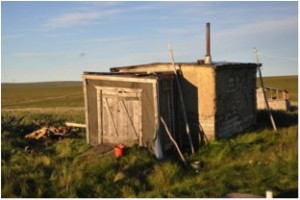
Ayutun accommodation (sleeping a group of 5) with greenhouse in the back (Photo: M. Schaepman, July 2013).
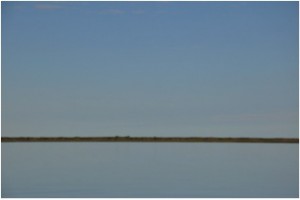
Indigirka river (foreground), floodplain (middle-ground) and for once a blue sky (background) close to Ayutun (Photo: M. Schaepman, July 26, 2013).
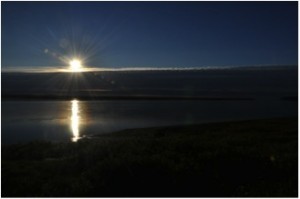
Still no sunset on July 26 in Ayutun (Photo: M. Schaepman, midnight, July 2013).
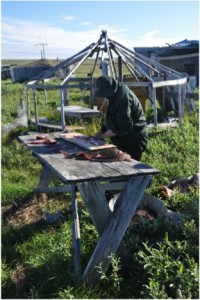
All you can eat fish every day! (Photo: G. Schaepman-Strub, July 2013).
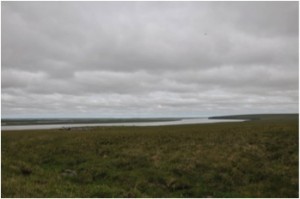
Ayutun hill site (max elevation about 300 m a.s.l.) with overview of the Indigirka river (as well as cold and bad weather moving out …) (Photo: M. Schaepman, July 2013).
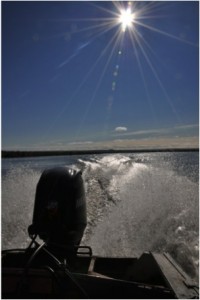
Early morning boat ride on the Indigirka back to Chokurdakh (Photo: M. Schaepman, July 2013).
Abgelegt unter: Up and running
26. July 2013 |
Veruska Muccione |
Comments Off on Freeze-thaw event observed in radar signatures as snow cover melts at Kytalyk, Siberia, Russia
by our staff writers
July 25, 2013
The following images illustrate the strong responses seen in radar backscatter data when the winter snow melts in the region, usually in late May and June. The data shown below was acquired by the ASAR sensor on the ENVISAT satellite in 2010. The data was acquired using the sensor’s “wide swath” (WS) ScanSAR mode, whereby beams are subsequently scanned across the landscape, enabling large areas to be covered in a single acquisition. The region shown is approximately 317km by 332km in size. ASAR WS medium resolution products were used, provided with a native 75m sample interval (150m resolution) in ground range geometry (azimuth and cross-range directions). The datasets were radiometrically calibrated using standard models and then geometrically terrain corrected using the SRTM30 1km resolution height model presented in a UTM map projection. The region is relatively flat, with some undulations visible in the southeast that could benefit from the use of a higher quality height model. Some small radiometric artefacts aligned in the satellite path (azimuth) direction are visible at the beam-boundaries due to the ScanSAR acquisition methodology. However, much stronger variations are caused by land cover changes taking place between the different acquisition dates. Dark backscatter indicates wet snow, while higher values can derive either from dry snow or snow-free land cover. Note how the melting begins in the south, progressing slowly northwards until there is none left by late June. The upcoming Sentinel-1 series of satellites, the first of which is due to be launched in early 2014, will be able to provide such observations with spatial and temporal resolutions both improved with respect to what was possible using ENVISAT ASAR.
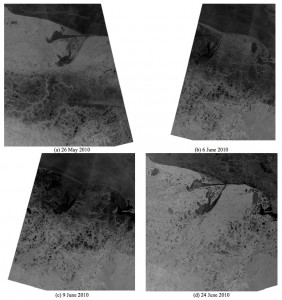
ENVISAT ASAR Data provided by the European Space Agency, 2010.
Abgelegt unter: General


































